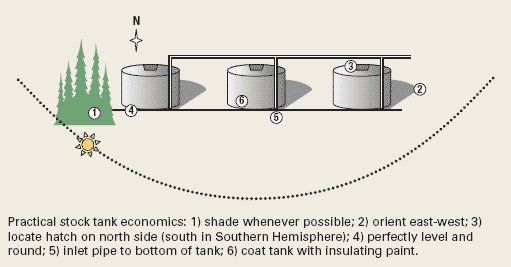PRODUCTION
TECHNOLOGY
Maximizing liquid sales from tank batteries
A
quick review of how proper stock tank setup, care and maintenance
can save you money.
Teddy M. Pledger, AGAPE Inc.
Many, if not most, of the practical aspects of stock tank economics
are known to operators. But a brief review is never a bad thing, and
if just one aspect of the construction, layout, equipping and coating
of an oil/condensate storage tank battery is not carried out with planning
and care, it could significantly affect the amount of liquid sold from
the facility.
TANK BATTERY LAYOUT
When the tank battery site is laid out,
make sure to align the tanks in an east-west direction, with the
tank’s hatch located on the
north side of the tank (south side in the Southern Hemisphere). Temperature
is one of the main correction factors applied to the gross sales volume.
The north side of the tank is the coolest side, since the sun doesn’t
shine much on the north side of the tank, and even when it does it’s
only in the summer near sunrise and sunset, depending on latitude.
On a 40°API-gravity oil, east-west orientation will increase sales
about 0.5% over the life of the facility.

The storage tank’s location must
be perfectly level for the tanks to be absolutely vertical. This
is essential, since the tables that are used to determine sales volume
assume that the surface area of the liquid in the tank is a circle.
If the tank is tilted, the surface area of the liquid becomes an
oval.
When the sales volume is determined, it
is based on the area of the circle measured between two heights (opening
gauge - closing
gauge). However, an oval has more area than the circle. So, if the
volume actually removed from the tank is an oval area measured between
those same two heights, then the more the tank is tilted, the greater
the volume “given away.”
TANK EQUIPMENT
A “down-comer” on the inlet of the tank should be installed
such that the oil/condensate is released into the tank near the bottom.
By entering the tank through the down-comer, flash calculations (40°API-gravity
oil at 120°F, entering the tank at atmospheric pressure and 100°F)
show that sales will increase by about 5% compared with that same liquid
entering the tank at the top and spraying into the tank.
The tank hatch must be able to hold a few ounces of pressure. The
gasket on the hatch must be in good condition. Install a vent valve
on the gas outlet from the tank. When the tank hatch and vent valve
are working correctly, there should be a sound of rushing wind when
the tank hatch is opened. If this sound not heard, something has malfunctioned
and repairs should be made immediately.
TANK COATING/INSULATION
Where possible, use a paint that has a low Solar Heat Absorption Factor
(SHAF), such as real aluminum paint, which has an SHAF of 31. Oil-based
paints are among the poorest options, since they all have about the
same SHAF, regardless of color.
According the book, Heat Transfer (Benjamin
Gebhart), the SHAF of oil-based paints varies between 0.92 and 0.98
(the higher the number, the greater the heat absorbed). Whatever
paint is used, the heat absorbed from the sun can be minimized by
blending into the paint additives that increase the paint’s
insulating properties, such as micro-balloons (see www.hytechsales.com).
One final note: It should be understood
that the higher the API gravity of the liquid, the more critical
all of the above points are to the volume of oil/condensate actually
sold. 
|
THE
AUTHOR |
|
Teddy
M. Pledger is president
of AGAPE Inc., an Oklahoma oil and gas producer and consulting
firm. He graduated from Louisiana State University in 1960 with
a degree in petroleum engineering and has worked for service
companies and major oil producers. He spent much of his career
teaching oil and gas related seminars around the world. He can
be reached at: tpledger2@cox.net. |
|



